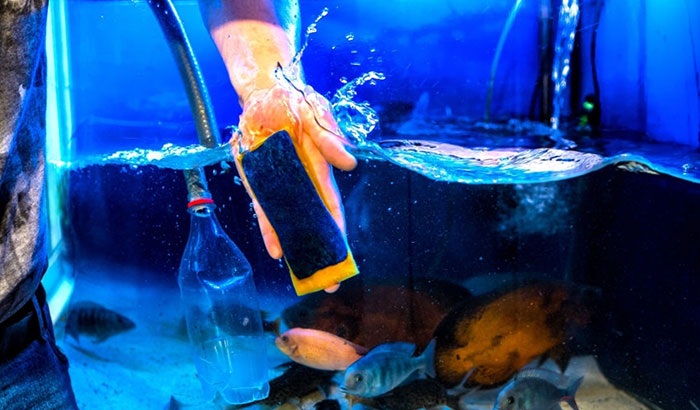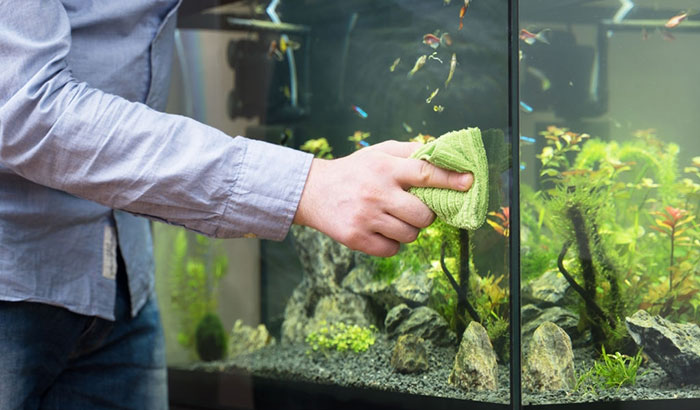All those who have a fish tank must be responsible enough to clean it. It helps the fishes keep healthy, and assures longevity, both for the fish and the fish tank itself. Even more so, one must know how to sanitize a fish tank after a disease outbreak. It will be a great loss if one lost the beloved pet fish due to negligence and failure on the owner’s part to clean the fish tank.
Here are some guides as to how to sanitize a fish tank after a disease outbreak to keep them healthy.
Contents
Preparing the Cleaning Materials
A fish tank is not like any other material, equipment, or apparatus that you can clean using just water and soap. Some parts of the fish tank require that it be cleaned with specialized, cleaning materials. One must use water, but aside from it, here are other cleaning materials you can use for your fish tank.
Bleach
You can use bleach to clean parts of the fish tank such as the glass, other parts such as filter hoses, gravels, rocks, and the like, as well as on plastic and artificial plants. Make sure that you applied the proper solution. Too much bleach may damage the parts or might prove unhealthy for your pet fish. Remember that you must not mix bleach with other solutions, only water.
Vinegar
You can use vinegar to cleanse almost any other part of the fish tank. Just make sure to apply the proper solution so as not to damage the parts of the fish tank.
How to Sanitize the Fish Tank after a Disease Outbreak?
Here is a step-by-step approach as to how to properly cleanse and sanitize the fish tank after a disease outbreak.
Prepare the Solution
The cleaning materials, water, soap, or bleach and vinegar, must be prepared. Make sure that you apply just enough of it to the solution. Too much concentration of soap, bleach, or vinegar to water may increase the toxicity of the objects about to be sanitized. It might affect the health of your pet fish that might result in another disease outbreak or even death.
Put the Fish in Another Tank
You must have another tank that is itself clean, to put your pet fish while you are cleaning the fish tank. Scoop them out of the fish tank and put them in another container, rightly conditioned to make them healthy while you clean the fish tank.
Remove Parts of the Fish Tank
Empty the fish tank, remove everything, the parts that can be removed, and put outside the fish tank. It is important, for it allows you to clean extensively the interior of the fish tank. It also allows you to clean extensively those individual parts that may house bacteria and others that led to a disease outbreak.
Drain the Fish Tank
Pour some water in it, maybe a bucket or less, then drain the fish tank of all the water. If the fish tank is small, you can just turn it to empty it of water. For large and big fish tanks, you can use a specialized hose to drain all the water.
Wipe the Fish Tank
Using a towel or paper cloth, you can dry the fish tank to remove the remaining dirt and dust. Wet the paper towel or cloth with warm water, then wipe all the sides of the fish tank, left to right, top to bottom.
Apply the Solution to The Fish Tank
After draining it of water, you can apply the solution, whether bleach or vinegar, to the fish tanks. One must apply the proper solution, for bleach, one can use an 8:1 water bleach ratio.
For vinegar, you can use a 1:1 vinegar/water ratio. You can spray the solution on the fish tank or put the solution itself. Do not let the solution in the tank for more than 10 minutes.
Clean the Parts
All the parts of the fish tank that were removed; plastic and artificial plants, filter hose, even gravel, and rocks. Must be cleaned thoroughly. One can use a bleach or vinegar solution to clean the parts. For bleach, one can use an 8:1 water/bleach ratio, and then apply it to fish tank parts, either by rinsing it or soaking it for 10-15 minutes.
In using vinegar solution, you can apply the 1:1 ratio of water/vinegar. You can soak the removed items in the vinegar solution for several hours. You can also apply the vinegar solution to the fish tank itself, putting the solution on the fish tank and let it stay there for several hours. Vinegar solution also works best in removing mineral deposits.
Rinse Thoroughly
All materials and items cleansed by bleach or vinegar solution must be rinsed by water and must be rinsed thoroughly. This is to ensure that toxic chemicals will not stay in the items, so as not to be harmful to the pet fish and damaging to the items. This includes all the items that were removed as well as the fish tank itself. If possible, rinse it a couple of times.
Dry the Fish Tank and The Parts
Let the fish tank as well as other removed items dry for twenty-four hours. This is to ensure that no harmful chemicals from bleach or vinegar solution remain to the items or in the fish tank. Even if some chemicals remain, they will break down into harmless elements within twenty-four hours.
Put Back the Items
All the cleansed and removed items must be put one by one, in proper places. Never add something that was never cleaned or sanitized for it might contaminate the fish tank.
Refill the Fish Tank with Water
After everything has been put into place, you can put water in the fish tank. Make sure that the water you put is clean, so as not to cause any disease outbreak in the future.
You can also use chemicals that are proven to help maintain the water in good condition, a Dechlorinator, for instance. This is to ensure that water will stay in good and will not get easily toxic or contaminated.
Conclusion
Learning how to sanitize a fish tank after a disease outbreak is easy. You only need to be quite engaged and be familiar with some cleaning materials and methods to ensure that your pet fish will live healthier and longer.


